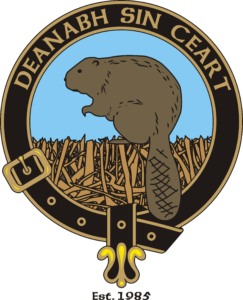Tue 8/21 and Wed 8/22 three of us stayed at Mizpah Springs hut south of Mt. Pierce in the southern Presidential Range. We hiked up from Rte 302 at Crawford’s with the mission of brushing out Crawford Path at Mt. Eisenhower, paid for by a grant from REI through the National Forest Foundation and the White Mountains Trail Collective, of which we are a member crew.. Two of us spent two hours restoring the first 25 drains on the Mizpah Cutoff as you hike back towards Crawford Path before supper, while the third got a late start and arrived just in time to join us at table. In the evening we got settled in and enjoyed a very informative talk on the Crawford Path project by Cristin Bailey, the Project Manager. Our hike-in and work time totals 13 hours that day. Three Old Hutmen ranged far ahead and cut brush near Mt Eisenhower.
On Wednesday it rained all day save for an hour in the afternoon, when we sawed out two fir leaners over bog bridges near the hut on the Appalachian Trail, there Webster Cliff Trail. We limbed the logs and scattered the slash off in the woods; the logs need only be peeled to use as bog bridges or waterbars. They were forcing hikers and hut croo with large packs to lean outwards and away from them, not very safe, and we were told to clear to the AT standard: a 4′ wide by 8′ high opening for hikers. The rest of the day we read from the hut library and discussed trailwork with a worker from the AMC Pro Crew who was the evening program. Our work time totals four hours for that day. Two Old Hutmen went home that morning, one stayed and worked with us when he wasn’t volunteering on the front desk.
BTW, for local interest: In Forest and Crag the Watermans discuss how in 1966, two years after the hut opened, an AMC trail crew leader named Alan Thorndike was trying to keep the Mizpah Cutoff hikeable across boggy flats near the hut. Corduroy just sank into the mud (we walked over a few survivors), and he came up with the idea of using peeled logs to hold many small rocks together as a base for the trail tread. This is now called turnpike. We hiked over those structures on Tuesday, and cleaned 25 waterbars on that stretch that were mostly filled with sediment. They are hard to keep clean when the outflow ditch is level, and some really are on flat ground. More interesting: in the June 1968 edition of Appalachia in the hut library is a photo (top left in a montage) that looks like seven of the 1966 or ’67 Pro Crew building that turnpike exactly as we found it in a weathered condition 51 years later. They have long Beatles haircuts and are wearing chino pants and long-sleeve dress shirts, like in a college classroom of that era. I say the Pro Crew because so far as I know there were no volunteers involved, but I don’t claim to know everything about them either.
Thursday was clear with a NW breeze. Along with the remaining Old Hutman, we packed our gear and hiked up Webster Cliff Trail and Crawford Path to Mt. Eisenhower, stopping to fix the signs where Crawford Path meets Webster Cliff Trail. The bottom of the post had rotted away and the signs were on the ground beside a rockpile that used to be its cairn. We sawed off the bottom foot of the post and reset it in the center of the rockpile on flat rocks for better drainage then cairned around it with large rocks on top of the pile to buttress it against the winds, see photos.
We reached the junction with Mt. Eisenhower Loop around 2 PM and continued on, passing the SCA Bear Brook crew brushing northbound. There are interesting portions where the original route has collapsed and scrambling is required. When we got to the north junction with Eisenhower Loop we decided that the day was far along, we had five miles to hike down to our cars, and we had to accomplish our most critical job. The Old Hutman continued brushing the narrowest parts of Crawford Path while we found twisted spruce in the woods over the ridge and used them to barricade bootleg paths as best we could, weighing them down with loose rocks but disturbing no soil, see photos of barricades. Restoring the alpine plants to those paths is possible, but we had only so much time and a specific job to do.
By then it was 4 PM. We descended the 2.9-mile Edmands Path, which is another discussion. At 8:20 PM we turned south and walked Mt. Clinton Road about 2 miles back to our cars, arriving at 10 PM. That made for 13 hours each for three CHVTC and one Old Hutman that day. Our fatigue may be imagined, but we did our best to accomplish the most important parts of our mission.
Respectfully submitted,
Craig Sanborn, CHVTC
